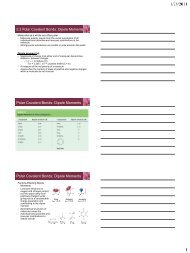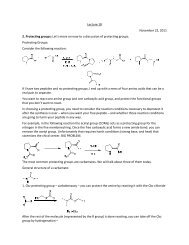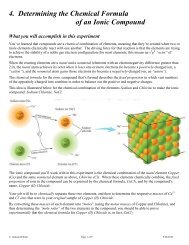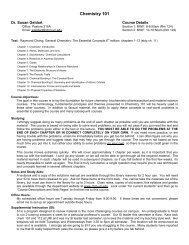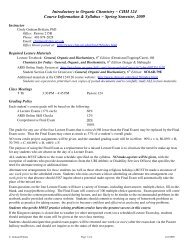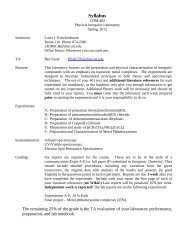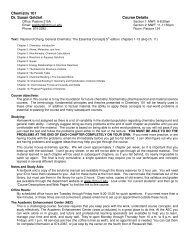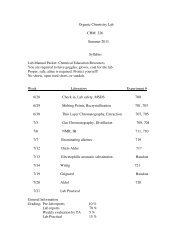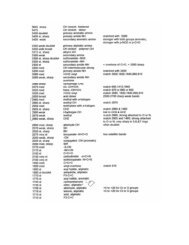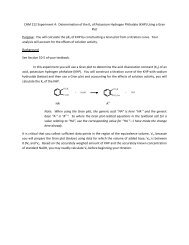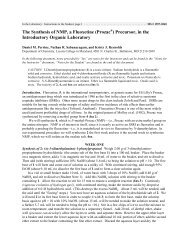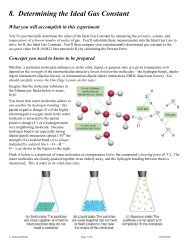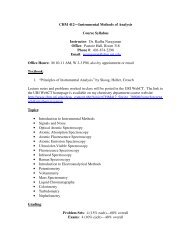Advanced Physical Chemistry I Course Syllabus Fall 2008 - URI ...
Advanced Physical Chemistry I Course Syllabus Fall 2008 - URI ...
Advanced Physical Chemistry I Course Syllabus Fall 2008 - URI ...
- No tags were found...
Create successful ePaper yourself
Turn your PDF publications into a flip-book with our unique Google optimized e-Paper software.
<strong>Chemistry</strong> 531 - <strong>Advanced</strong> <strong>Physical</strong><strong>Chemistry</strong> I<strong>Course</strong> <strong>Syllabus</strong><strong>Fall</strong> <strong>2008</strong>1. Instructor: David L. FreemanPhone: x 4-5093Office: 333, 319 Pastoree-mail: freeman@chm.uri.eduOffice Hours: MWF 10 AM2. Scheduling: TuTh, 8:00-9:15 AM, 219 Pastore3. Text: Statistical Mechanics by Donald A. McQuarrie, University Science Books, 2000.4. Prerequisites: CHM432 or permission of instructor.5. <strong>Course</strong> requirements:(a) Two one hour exams at 100 points each 200(b) Homework 50(c) Final exam 200(d) Total 450Grades will be determined on a curve with B as the average. All exams will be closedbook. Incompletes will be given only for valid medical reasons.6. <strong>Course</strong> Topics:This semester we will study the branch of physical chemistry known as statisticalmechanics. In statistical mechanics we apply the principles of statistics to determinethe macroscopic behavior of bulk systems from the microscopic laws of nature. Anexample of the tasks of statistical mechanics is the determination of the temperaturerise of a piece of chalk (CaCO 3 ) when 1000. Joules of heat are added to it, without1
doing any macroscopic measurements. In other words, we want to be able to calculatethe heat capacity (as well as other bulk properties) of calcium carbonate (or any othermaterial) from first principles. The real goal is not just the heat capacity. We canalways measure it. Our true goal is a microscopic understanding of the bulk behaviorof materials.The area of physical chemistry concerned with bulk properties alone is thermodynamics.Since we want to obtain a microscopic understanding of thermodynamics, in thiscourse it will be assumed that you remember some of the thermodynamics you learnedin your undergraduate physical chemistry courses. To help you remember, we willspend the first few weeks of the semester reviewing the laws of thermodynamics. Asindicated, we will also need to know something about the microscopic laws of nature.Consequently we will also outline those results of classical and quantum mechanicsneeded to develop statistical mechanics.As is evident from its name, in statistical mechanics we apply the laws of statistics toconnect microscopic to bulk behavior. We will spend considerable time developing theneeded statistical laws. We then can develop statistical mechanics itself, including thestudy of ensembles and fluctuations, and applications to ideal and real gases, crystalsand chemical equilibrium. A detailed outline follows.7. The CHM 531 Web page:In this course all problem set solutions and exam solutions are to be distributed on thecourse web page. No paper copies of the solutions are to be distributed. The URL ofour course web page ishttp://www.chm.uri.edu/courses/?chm531&1 . It is strongly suggested that you linkto our web page as soon as possible. If you have no web access, please see me and Ican arrange web access for you.It is expected that for most of you, success in this course will require some level of helpbeyond classroom instruction. Because some of you work off campus and may find itdifficult to come to the scheduled office hours, we have installed as part of our courseweb pages, a page that can be used to submit questions. Questions are submitted byanyone in the class by filling out a form on the web page, and answers are distributedeither to the entire class or only to the person asking the question. If the entire class isto receive a copy of the question and answer, the question is treated as anonymous; i.e.the person who asks the question is never identified. In fact, it is possible to submita question so that even the instructor does not know who submitted the question.Anonymous questions and responses by the instructor are distributed automaticallyto everyone who has submitted their e-mail address to the instructor. With ordinaryelectronic mail, there is a private correspondence between the student and instructor.By using the web page, the entire class has an opportunity to learn from the questionssubmitted.The use of the web page does not preclude personal interaction between any of you and2
the course instructor. My office is always open to graduate students, and you are allencouraged to come to my office for help. Additionally, you can contact me by e-mailor telephone. My e-mail address and phone number are given on the first page of thissyllabus.If any of you have no access to electronic mail, please see me. I can arrange anaccount for you on one of the <strong>Chemistry</strong> Department computers. Alternatively, all<strong>URI</strong> students are entitled to an account on the University’s computers. If you wishto use the University’s computer for e-mail, you should contact the User ServicesDepartment at the Academic Computer Center in Tyler Hall. You can access a webbrowser using computers distributed throughout the campus. If you need help withsuch access, see me.To receive copies of the submitted questions and the answers to the questions, youmust submit your e-mail address. There are two methods for subscribing to the CHM531 list. In the first method send your e-mail address to freeman@chm.uri.edu. Thesubject of the message should be “CHM 531 e-mail list,” and the text should containthe e-mail address you would like to use. It is important to identify yourself as astudent in CHM 531, so that your name is not added to the list associated withanother course. The second method uses our web page. As before, go to our homepage (http://www.chm.uri.edu/courses/?chm531&1 ) and click on“Subscribe to theCHM 531 list.” On the resulting form, enter your e-mail address, click on the small“subscribe” button and then click on the submit button. You can also use this formto unsubscribe from the list in case you drop CHM 531.Any student in CHM 531 can submit questions and comments to me. Submission ofsuch comments or questions must be made using the WWW home page for this course.The address (URL) of our home page ishttp://www.chm.uri.edu/courses/?chm531&1 . To submit a question to the list, youmust click on the highlighted text that says “submit a question to the CHM 531list.” As an example of how to use the list, suppose a student in our class, Ms. BenzeneRing, wonders, “How can you tell if a particular particle obeys Fermi-Dirac orBose-Einstein statistics?” (If you don’t know what this means, don’t worry. You willunderstand the question during the semester). To obtain an answer to her question,Ms. Ring links her web browser (e.g. Netscape or Microsoft Internet Explorer) tohttp://www.chm.uri.edu/courses/?chm531&1, and she then clicks on the text linkingher to the page for questions (i.e. the highlighted text that says “submit a question tothe CHM 531 list”). Ms. Ring then enters her e-mail address in the appropriate boxand specifies whether she wants her question to be answered to the entire CHM 531list or to her alone. Ms. Ring then types in the large boxHow can you tell if a particular particle obeys Fermi-Dirac or Bose-Einsteinstatistics?Ms. Ring then clicks the “send” button. Ms. Ring’s question is received by me. I thensend an e-mail message to the whole list that might be3
Subject: Fermi and Bose StatisticsThe question is: How can you tell if a particular particle obeys Fermi-Diracor Bose-Einstein statistics?Answer: Particles with integer spin (like a helium atom with 2 neutronsand 2 protons) are Bosons and particles with half-integer spin like electronsare Fermions.Now Ms. Ring and the entire class have an answer to her question.If the answer to the question can be sent to the entire list, the answer will not indicatewho asked the question. If Ms Ring wants to ask the question with full anonymity sothat even I have no idea who asked the question, the e-mail portion of the form canbe left blank. Of course, if the e-mail section of the form is blank, the answer must besent to the list and not just to the sender.Because many questions may contain mathematical formulas, we need a notation tocommunicate the special symbols used in the course. To avoid confusion, it is mostuseful if we agree on the same set of symbols. The symbols that follow are takenfrom a language called L A TEX. L A TEX is a language that is frequently used to preparescientific documents, and L A TEX can be used to translate special symbols into simpletext characters. By learning L A TEX notation, you will learn a widely used methodto communicate mathematical symbols via e-mail. The instructor plans to use thesesymbols in answering your questions, and it is asked that you use the same symbols inposing questions. The most important symbols are the following:(a) Greek letters are represented by \ followed by the name of the letter. For exampleα is typed \alpha, β is typed \beta, and so on. A Greek letter is made uppercase by making the first letter of its name upper case. For example, the letter ∆is typed \Delta.(b) Subscripts are represented by {} where the brackets contain the subscripts. Forexample, µ ij is typed \mu {ij}.(c) Superscripts are represented by ˆ{} where the brackets contain the superscripts.For example, β 12 is typed \beta ^{12}.(d) Infinity (∞), is typed \infty.(e) The integral sign ∫ is typed \int. The limits on a definite integral are includedby introducing subscripts and superscripts. As an example ∫ ∞0 e −x2 dx is typed\int {0} ^{\infty} e ^{-x ^{2}} dx.(f) The partial derivative symbol ∂ is typed \partial.(g) The summation sign ∑ is typed \sum. The lower and upper limits of summationare included as subscripts and superscripts. As an example ∑ ∞n=0 1/n 2 is typed\sum {n=0} ^{\infty} 1/n ^{2}.4
(h) Square roots √ a + b are typed \sqrt{a+b}.(i) The arrow in chemical reactions → is typed --->. For example C+O 2 → CO 2 istyped C + O {2} ---> CO {2}.Let us now look at another example of a question submitted using the web. In thiscase, Ms. Ring has a question requiring an equation. This might be a real question.If you don’t understand the context, don’t worry. You will understand the details ofthe question later in the course. Suppose Ms. Ring wants to ask“In evaluating thermodynamic properties from the partition function in a given ensemble,when differentiating, how can you determine which variables remain constant?For example, the internal energy is given by U = −(∂ ln Q/∂β) N,V in the canonicalensemble. How do you decide to keep N and V constant?”To submit the question, Ms. Ring uses her web browser to attach tohttp://www.chm.uri.edu/courses/?chm531&1, clicks on the line that says, “submit aquestion to the CHM 531 list,” and then Ms. Ring enters the information requestedby the form. If Ms. Ring wishes to remain anonymous, Ms. Ring leaves the e-mailbox blank. Ms. Ring then types into the large boxIn evaluating thermodynamic properties from the partition function in a givenensemble, when differentiating, how can you determine which variables remainconstant? For example, the internal energy is given by U=-( \ partial lnQ/ \ partial \ beta) N,V in the canonical ensemble. How do you decide tokeep N and V constant?and clicks on the submit button. Ms. Ring’s question is received by me. The answerwill be sent either to Ms. Ring alone, or preferably to the entire class if the appropriatebox is checked. I might replySubject: variables in each ensembleThe question is: In evaluating thermodynamic properties from the partitionfunction in a given ensemble, when differentiating, how can you determinewhich variables remain constant? For example, the internal energy is givenby U=-( \ partial ln Q/ \ partial \ beta) N,V in the canonical ensemble.How do you decide to keep N and V constant?The answer is: You need to think about the natural variables defined ineach ensemble. For example, in the canonical ensemble, the natural variablesare N,V and T (or \ beta). When differentiating with respect to \ beta,you then must keep N and V constant. As another example, in the microcanonicalensemble, N, E and V are the natural variables.Remember, your first task is to subscribe to the CHM 531 list either by e-mail or fillingout the form on our web pages. You can then send questions and comments to me5
using your web browser starting at the URLhttp://www.chm.uri.edu/courses/?chm531&18. <strong>Course</strong> outline:TopicReading Assignment1. Review of Calculus2. Review of Thermodynamics Atkins and de Paula,7th Ed.,Chapters 1-103. The results of quantum theory4. The random walk and the laws of statistics Handout5. The canonical ensemble Chapter 26. Exam 17. The ideal monatomic gas Chapter 58. Other ensembles and fluctuations Chapter 39. Quantum statistics Chapter 410. Ideal diatomic gas Chapter 611. Chemical Equilibrium Chapter 912. Classical mechanics Chapter 1, section 2and handout13. Classical statistical mechanics Chapter 714. Exam 215. Crystals Chapter 1116. Distribution Functions in Real Classical Fluids Chapter 1317. Final Exam Comprehensive6



